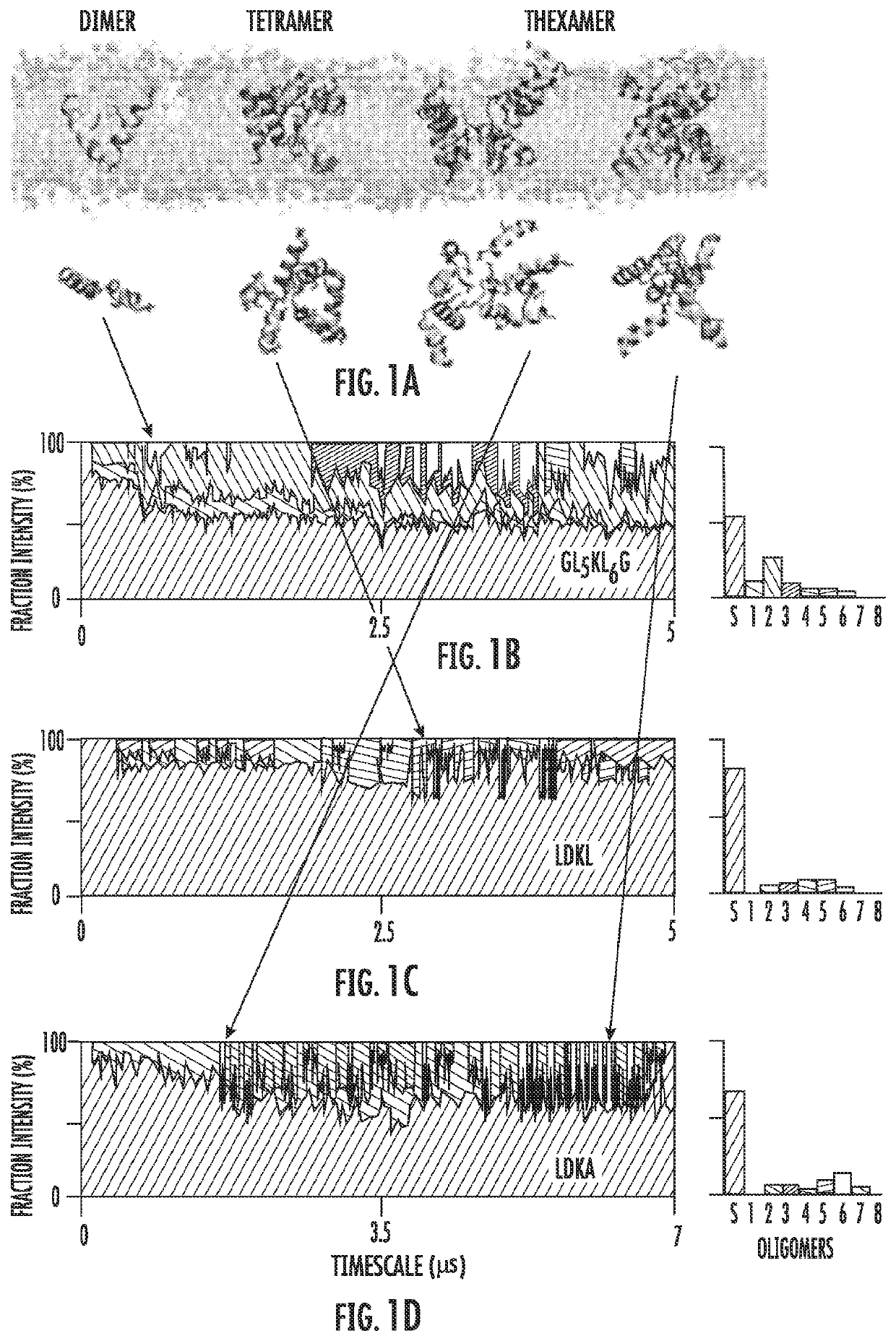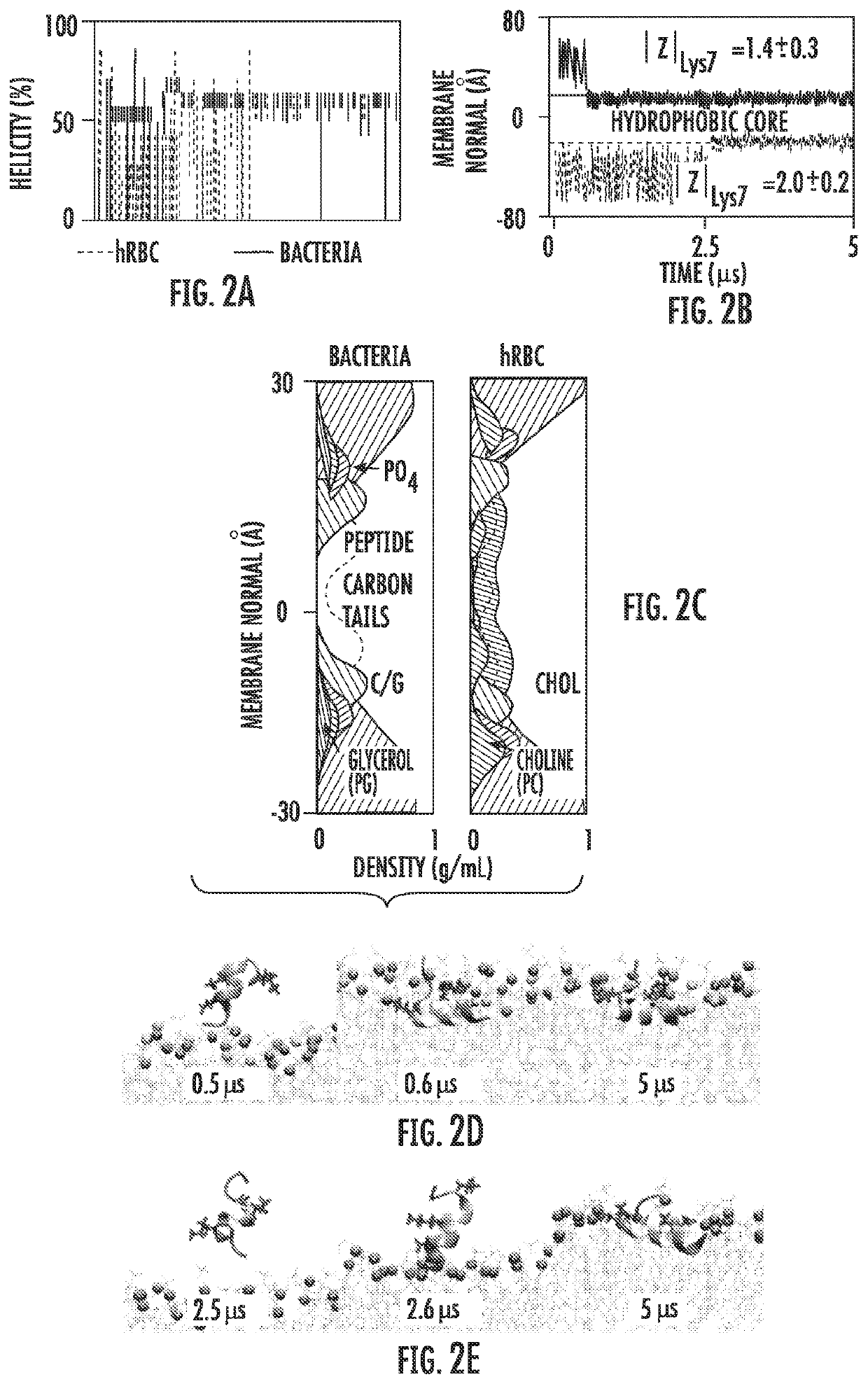Antimicrobial peptides and methods of making and using same
a technology of antibacterial peptides and peptides, applied in the field of antibacterial peptides and methods of making and using same, can solve the problems of preventing the root cause of amp activity from being understood, and presenting a significant challenge for rational de novo design of amps
- Summary
- Abstract
- Description
- Claims
- Application Information
AI Technical Summary
Benefits of technology
Problems solved by technology
Method used
Image
Examples
example 1
[0119]Simulation-guided de novo design of AMPs from a simple peptide template.
[0120]The inventors showed that polyleucine-based peptides (e.g. acetyl-GLnRLnG-amide; n=5-8) (SEQ ID NO: 27) that have the basic characteristic required of an AMP: they bind strongly to lipid bilayers20 and continuously flip between surface bound (S) and transmembrane (TM) inserted helical conformations.21 To design an AMP starting template, the inventors first modified this sequence to GL5KL6G (NH3+-GLLLLLKLLLLLLG-CO2−) (SEQ ID NO: 1, Table 1) replacing arginine with lysine since glycine, leucine, and lysine are the most abundant amino acids in short helical AMP sequences.18 The neutral acetyl and amide termini are replaced by charged amino (NH3+—) and carboxy (—CO2−) terminal groups to increase solubility and promote pore-forming electrostatic peptide-peptide interactions.22 The hydrophobic length is selected to lie between GL5RL5G (SEQ ID NO: 28), which is 7±2% transmembrane (TM) inserted and GL6RL6G (...
example 2
[0126]In addition to spontaneously assembling into functional pores, the biological activity of pore-forming AMPs depends crucially on their ability to bind strongly to lipid bilayers without precipitating out of aqueous solution. Unbiased peptide folding-partitioning simulations of a single peptide (FIGS. 2A-2E) predict that LDKA strongly binds and folds onto both human red blood cell (hRBC) (DMPC:PSM:CHOL=1:1:1) and bacterial (Bac) model membranes (DMPC:DMPG=3:1). The peptide, which is initially placed in a fully extended conformation in bulk aqueous solvent>15 A from the membrane spontaneously absorbs and folds onto the interface of the bilayers. No dissociation events are observed over the 5 μs simulation timescale, suggesting strong binding. Unlike many other membrane active peptides we have studied previously, LDKA acquires some helicity in solution before binding to the membrane interface. Once bound, the helicity of monomeric peptides remain ˜63% for both hRBC and bacterial ...
example 3
[0128]To validate the simulation-guided peptide design methodology LDKA was solid-phase synthesized, purified, and functionally characterized in vitro using biophysical techniques and biological assays.
[0129]FIG. 3A shows circular dichroism (CD) spectra of LDKA in aqueous solution as well as in the presence of modeled hRBC and bacterial model membrane large unilamellar vesicles (LUVs) at pH=7. The lipid composition of the vesicles was identical to the simulations and the results confirm that LDKA is indeed soluble (<0.1 mg / mL in 1×pH 7.4 DPBS) and partially helical in solution, and spontaneously binds to both membrane types, increasing the helicity from 45% to 78%. The helical fraction of membrane-bound LDKA peptides agrees with the equilibrium LDKA assembly simulations at 50° C., which is 78±2% (Table 4), while the aqueous helicity is lower in the experiment, suggesting a structural bias in the molecular simulation force field.
[0130]Pore-formation was determined using a membrane le...
PUM
| Property | Measurement | Unit |
|---|---|---|
| pH | aaaaa | aaaaa |
| temperature | aaaaa | aaaaa |
| particle size | aaaaa | aaaaa |
Abstract
Description
Claims
Application Information
 Login to View More
Login to View More - R&D
- Intellectual Property
- Life Sciences
- Materials
- Tech Scout
- Unparalleled Data Quality
- Higher Quality Content
- 60% Fewer Hallucinations
Browse by: Latest US Patents, China's latest patents, Technical Efficacy Thesaurus, Application Domain, Technology Topic, Popular Technical Reports.
© 2025 PatSnap. All rights reserved.Legal|Privacy policy|Modern Slavery Act Transparency Statement|Sitemap|About US| Contact US: help@patsnap.com



